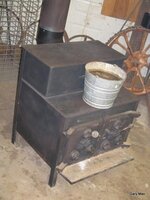Gary Max
Member
Fired up the wood stove today----first time this year.
I have some Hickory Burl that was sealed in Anchorseal a couple of months ago that I am wanting to dry.
Here's the easy way to dry blanks I know of.
2 1/2 gallon bucket of water and a hot stove---I just leave it sit and brew all day long.
Tonight they will be placed on a drying rack to dry.
I have some Hickory Burl that was sealed in Anchorseal a couple of months ago that I am wanting to dry.
Here's the easy way to dry blanks I know of.
2 1/2 gallon bucket of water and a hot stove---I just leave it sit and brew all day long.
Tonight they will be placed on a drying rack to dry.
Attachments
Last edited:


